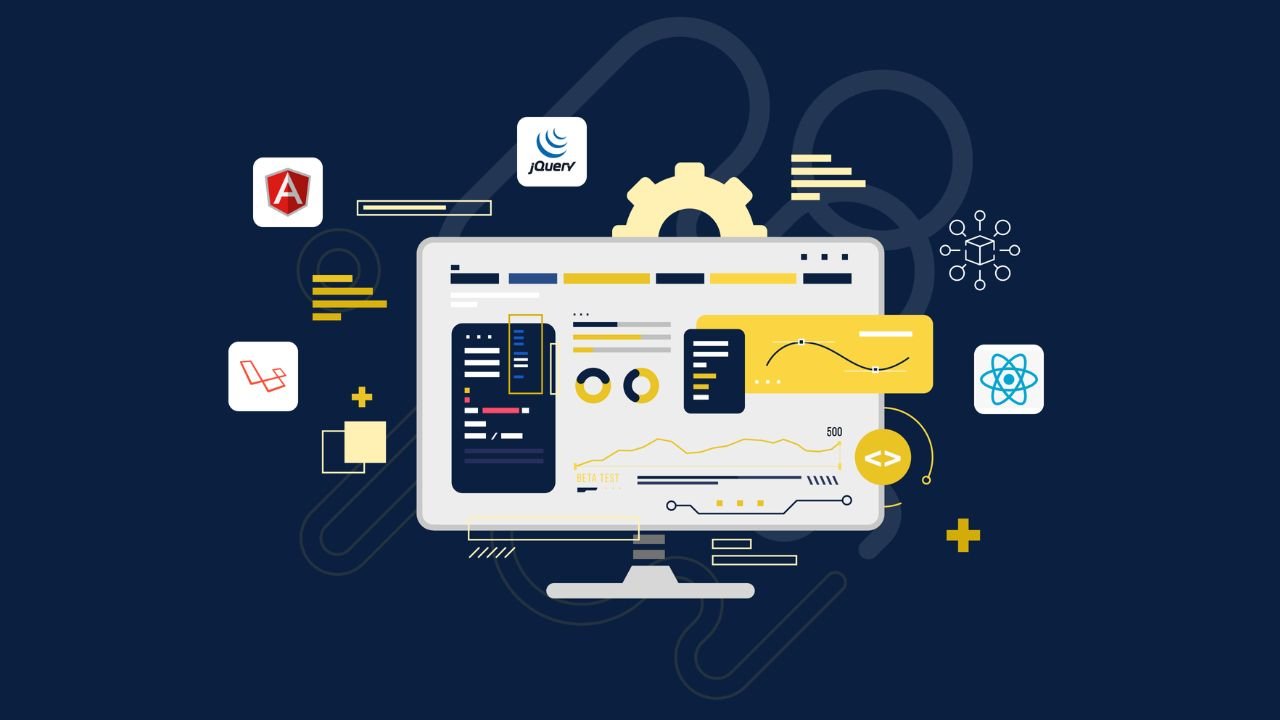Several tools and libraries in web development frameworks are mostly used by developers as they build a website. It is the framework that speeds up and makes the development process less complicated. Such dynamics help to ease the process of creating and running websites and web apps.
All businesses and software developers should make sure they have a presence on the web. Web developers may need suggestions on which framework is best for their project website. Because the requirements for applications are increasing, more people are relying on web development frameworks. When using famous web development frameworks, designers have the means to make multifunctional websites and applications that give users an exceptional experience.
Facing the huge collection of web development frameworks and being amazed by the strict expectations set by senior engineers. You have to select a framework as its performance will affect your site’s future.
According to the study done by Statista in 2022, Node.js was preferred by 44.5% of developers which was more than React.js. Out of all the developers, React was named by as many as 40.58 percent of them. Node was mentioned by 42.65 percent of respondents and JavaScript as well. JavaScript.
The importance of assuring a web application’s accuracy and speed also lies in using automation testing that plays a crucial role. If automation testing is included in the frameworks, it will raise the quality of the source code and also simplify testing.
The importance of Web Development Framework cannot be underestimated.
A web application framework is made up of well-liked tools, libraries and rules to help you build online apps more easily and without difficulties. It takes charge of tasks including routing, talking with databases, registering sessions and authentication, so the framework can focus on other features. It creates a helpful system and guidelines for using the standard framework to develop web apps.
The front-end and back-end development frameworks are some of the options, so the users can include content management, data binding, server-side processing and UI components in their projects. It’s easy to work with these libraries through many programming languages. When the project requires a set framework, the developers have a wide range of web development frameworks to choose from. The reason is that web frameworks make it easier to use a common approach and the final result is scalable, reliable and can be maintained.
There are several web development framework types.
A web development framework that covers both front-end and back-end will save time and reduce the need to develop code manually since the system includes ready-made tools and code for every section of an online application.
When it comes to front-end frameworks, they deal with building the user’s interface and supporting the basic structure of web applications.
Unlike front-end frameworks, back-end frameworks mainly handle server-side activities. With the framework, the back-end of the application gets systemized, along with the ability to render web pages on the server, handle database functions and make APIs. No list of back-end software would be complete without highlighting Django, Express and Ruby on Rails.
Key Points that Distinguish Front-End from Back-End Frameworks
Here is a table showing a comparison between front-end and back-end frameworks:
| Aspect | Front-End Frameworks | Back-End Frameworks |
| Definition | Focuses on client-side development of web applications, managing user interface, interactivity, and user experience. | Concentrates on server-side development, handling database interactions, processing requests, and implementing business logic. |
| Languages | Extensively uses HTML, CSS, and JavaScript. | Works well with different programming languages including JavaScript (Node.js), Python (Django), Ruby (Ruby on Rails), PHP (Laravel), Java (Spring Boot), and others. |
| Functionality | Manages presentation and user interactions in the web browser. | Manages data, business logic, and server-side operations. |
| Examples | React.js, Angular, Vue.js, Ember.js, etc. | Express.js, Django, Ruby on Rails, Laravel, Spring Boot, etc. |
| Client Interaction | Deals with user interactions and rendering content in the web browser. | Handles server-side operations, database interactions, and business logic. |
| Rendering | Renders views and user interfaces dynamically in the browser. | Generates dynamic content on the server-side and sends it to the client for rendering. |
| Routing | Handles client-side routing and navigation within the web application. | Manages server-side routing and directs incoming requests to appropriate handlers. |
| Data Manipulation | Manages data on the client side, often interacting with APIs and servers for data retrieval and updates. | Manages database interactions, data processing, and manipulation on the server side. |
| State Management | Often utilizes state management libraries like Redux or Context API for managing application state. | Manages application state and data persistence using databases and server side storage solutions. |
| Performance Optimization | Focuses on optimizing client-side rendering and interactivity for improved user experience. | Focuses on optimizing server side performance, database queries, and response times. |
| Security | Primarily concerned with client-side security measures, such as input validation and protecting against XSS attacks. | Implements server side security measures, such as authentication, authorization, and data validation to prevent security vulnerabilities. |
Outstanding Web Development Frameworks set to become popular in 2024
In 2024, a lot of web development frameworks will hold their place as common and effective tools to build dependable and flexible programs for the web. These include some of the most important frameworks in network security.
React.js
Facebook’s React.js is admired for helping to generate user interfaces without any lag. The main strength of React is that it follows a component-based model, making it simple for programmers to make reusable components. The Virtual DOM technique in react.js means only parts of the app that need to be changed are rerendered after some data has changed. Using React.js makes it convenient for developers to build SPA websites because of its popularity, quickness and the quality of the developer experience. This exceptional performance from React.js is an identical point and allows programmers to work in a user-friendly environment.
Vue.js
The framework Vue.js has been complimented for being easy to use and adaptable when building interactive websites. Because Vue.js is adaptable, it adds value to any older project and lets you work with complex UIs, using its responsive data binding and basic template terms. It is suitable for every developer, new or experienced, as it is user-friendly and not big in size.
Angular
Thanks to Google, Angular provides all the tools developers need to create web applications. For building enterprise apps that require a lot of features, Angular is ideal since besides MVC, it supports dependency injection and allows data to be updated in two directions. Angular’s scalability and stability show that it is dependable for developing applications used by many people thanks to the wide range of tools it offers.
Svelte
Targeting compilation-time processing, Svelte greatly improves the speed of a website’s operation. Instead of building regular frameworks, Svelte generates swift and small JavaScript code directly from components during the build process. Because it follows a neat and efficient process, it’s a strong choice when making modern apps online.
Express.js
Thanks to its simple design, with Express.js developers can quickly write online apps and APIs that are scalable using Node.js. Thanks to its neutral and flexible nature, ZeroMQ can be applied to many integration scenerios and circumstances.
Django
Django stands out among web frameworks since it comes with many tools and is designed with a “ready-to-use” approach. Django includes admin tools, user registration and ORM database mapping which are provided in a way that follows the MVC design. In Django which follows the DRY idea closely, creating a Python web application quickly and making it scalable thanks to built-in features and standards is very straightforward.
Ruby on Rails
Many people refer to Rails as Ruby on Rails which makes it a recognized Ruby web application framework. By following the CoC philosophy, Rails makes development faster and helps programmers follow the best practices. Rails is a powerful framework that makes web development efficient and attractive. Because it has built-in features for database transactions, HTML templates and routing, you can create applications fast and easily.
Laravel
The Laravel PHP web framework pleases developers because of its clear API, easy-to-understand syntax and large array of features. Thanks to routing, authentication, caching and database migrations, Laravel uses MVC architecture to make coding easier and more visible to developers. The reason Laravel is popular for creating modern and effective PHP programs is that it makes use of Blade for templating and Eloquent ORM.
Things to Consider While Choosing a Web Development Framework
There are some basic points to consider before you start with a web development framework.
- Quick Set Up: Pick a framework that ensures you can set it up easily and does not depend on several external elements.
- While you are developing, check that there is clear documentation and an active community on hand to assist you.
- When selecting a framework, select one that matches the project’s goals and a license which you can use for distribution without problems.
- Choose frameworks that can handle changes and grow as required in the future.
- Control and Budget: It is necessary to oversee expenses and evaluate how much the framework will cost to maintain and license.
- The learning curve for the framework should be considered, so your developers can use it soon after learning about it.
- For easing customization and extension, go with a framework that has these things.
Balancing UX, functionality and technical criteria can lead to successful results and aid in decision-making.
Make sure to check your websites on several browsers, devices and operating systems after finishing your development project with any framework. When you use LambdaTest, you can test websites developed with any of the web development frameworks you listed online on numerous real browsers instantly.
This platform offers the below tools and features.
- The use of Playwright, Appium, Cypress, Selenium and many other tools for web and mobile applications
- Use actual devices in the cloud for testing your web and mobile applications.
- The company has tested geolocation in 53 different nations.
- There are more than 120 third-party connectors available for Jira, Asana, Jenkins and additional tools you like.
- HyperExecute on the cloud allows you to accelerate your test automation.
Conclusion
Altogether, the available frameworks in 2024 can suit a variety of website development tasks. Both the front-end and back-end frameworks bring unique benefits for making advanced and scalable web applications. While choosing a framework, it’s important to care about how easy it is to set up, the thoroughness of its documentations, whether it can upgrade with the project, the validity of its license, whether it’s an affordable option and how quick it is to learn. A good user experience can only be achieved if testing is done on every popular browser, device and operating system. Plenty of platforms, for example LambdaTest, help you by providing testing features. Keeping pace with new trends and improvements in technology will help developers use web development frameworks to build effective and creative applications in 2024 and beyond.



